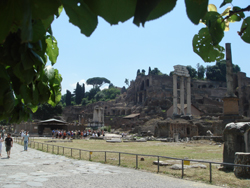An early start from
Zürich
this
morning for the Van
Gogh exhibition in Basel.
This Van Gogh exhibition promised to be an exciting
exhibition - a chronological display of the landscapes
of 70 Van Gogh paintings. This, the Kunstmuseum claims,
is the first exhibition comprised exclusivly of
Van Gogh landscapes from both public and private
collections.
Since I made my first, rather poor, attempt to copy
a Van Gogh self-portrait whilst at school art-classes
I've had a somewhat soft spot for the Impressionists
and post-Impressionists - Van Gogh in particular.
But there's no excuse to miss this gem.
From the very start of the exhibition, we are taken
on a chronollogical journey through Van Goghs life
which charts his life, his painting and the dramtic
change in styles from life Neuen, in the Duchy of
Brabant, to Paris, Arles in Provence, Saint Peters
Hospital in Saint Remy and, tragically, to Auvers.
We start at the beginning with the dark, earthy
browns of Neuen. The Church Tower a recurrent motif
through these and other painting of Neuen. Industrialisation
had taken hold in Brabant by this time and there
seems to an almost deliberate effort to keep any
evidence of it at bay these firmly rural pictures.
From this set of early paintings, the one which
does stand out is the Water Mill at Gennep (Carmen
Thyssen-Bornemisza Collection Collection) which lacks
some of the realisticness of the other pictures and,
instead, supplants it with the moodieness of an impending
storm. This could easily have been the works of a
Carravagisti if there were a greater emphasis on
realism - it has all the mood and expression.
Paris, and the exposure to art at his brother Theos
dealership, seems to to lighten the dark moodiness
quite noticeably. The views of Montmatre and the
visits to Parisian suburb of Asnières seem
to have changed the colours prefered by the young
Van Gogh to a cooler blue, more greens and reds.
Most dramatically, the "14th of July Celebrations" (from
a private collection) jar dramatically from his previous
Brabant works. In my opinion, this influence and
dealership was critical in allowing Vincent to develop
as a painter and, without which, he would not have
developed into the painter he became later.
If Paris had been a lightening process and an evolution,
Arles would be a revolution. It's hard to believe
that this is the same artists we saw at the beginning
- dark, broody, earthy, structured - transformed
into this. Brush strokes unstructured - almost anarchic.
Luminous. Bright. Light. F***ing brilliant. This
was no mere boy from a backwater - but an unacclaimed
genius at work. I have no idea what mental process
one goes through to achieve such a transformation
- if I did I'd be teaching philosophy in Paris not
running this blog.
Arles saw not only the luminous exuberance but acceptance
of the industrialization which was encompassing the
region. Industry now forms an integral part of the
pictures where before, especially in Neuen, it had
been studiously avoided. Bright corn fields at harvest
contrasted with the heavy, polluting industry in
the distant background. We had a hint of this during
Asnières - but nothing like this. The archaic
brushing, the light - Oh! I don't know! It's something
that is more satisfying to the soul than the more
ordered world of Monet / Manet or Pissaro. Almost
like an outpouring of oppression. To my eye, the Summer
Evening in Arles (Kunstmuseum Winterthur) and
the Provence Farmhouse (National Gallery of
Art, Washington DC, Ailsa Mellon Collection) are
outstanding paintings of this period.
In Arles, Van Goghs encounter with Gaugin - whose
work I never rated - left Van Gogh missing an ear
and sick. Interned at the Saint Pauls hospital, Van
Gogh painted when he could. Often confined within
the walls of the hospital, Van Gogh would often paint
in the gardens and occassionally outside where he
would be accompanied. The wave like composition of
the Olive Trees (which show the wall of the
hospital in the background - 1889 Museum of Modern
Art, New York City) gives us movement while the Cyprus
trees (1891, Museum of Modern Art, New York)
- religously significant to a religous man - give
us stillness. One wonders if this was deliberate
or the outpourings of an unwell extreme talent.
Perhaps most poigent is the last room - a portrait
of Mademoiselle Gachot, daughter of Van Goghs Dr
Gachot, is shown. He wrote to his brother Theo suggesting
that the portrait would be best displayed next to
the painting now known as "The Plains of Auvers." Sadly
these paintings are now seperated - the former displayed
here in Basel, the latter at the Belvedere in
Vienna
,.
It would be of no surprise if this exhibition would
be the most important art exhibition of 2009. It
shows the growth, evolution and lifetime of a troubled
man and artist. Perhaps with artistic irony, the
full extent of his influence was not acknowledged
in his own lifetime. Gaugin once saw Van Goghs paintings
and proclaimed him to be quite mad - a statement
he would later come to regret.
 My personal advise on what to do and see in Rome
My personal advise on what to do and see in Rome
 Mt Egmont seen from the King Edward Park playing fields in Stratford
Mt Egmont seen from the King Edward Park playing fields in Stratford
 The Stratford Glockenspeil in Taranaki
The Stratford Glockenspeil in Taranaki
 The Antelope - your local, dog friendly, beer friendly pub
The Antelope - your local, dog friendly, beer friendly pub
 Must see ancient monuments around Rome
Must see ancient monuments around Rome
 Historical information about the gothic Antwerp Cathedral
Historical information about the gothic Antwerp Cathedral
 What to see, where to stay and eat in historic Antwerp
What to see, where to stay and eat in historic Antwerp
 Recommended hotels in Vienna, Salzburg and Bregenz
Recommended hotels in Vienna, Salzburg and Bregenz